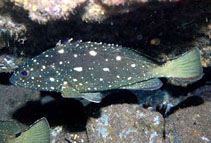| Family: |
Epinephelidae (Groupers) |
| Max. size: |
60 cm TL (male/unsexed) |
| Environment: |
demersal; marine; depth range 1 - 50 m |
| Distribution: |
Eastern Pacific: Baja California, Mexico to Peru, including the offshore islands of Cocos, Revillagigedo, and the Galapagos Islands. |
| Diagnosis: |
Dorsal spines (total): 11-11; Dorsal soft rays (total): 16-18; Anal spines: 3-3; Anal soft rays: 8-8. Distinguished by the following characteristics: olive green to reddish brown with scattered irregular white and brown spots and blotches; white triangle at the margin of the interspinous dorsal-fin membranes and bright white tag at the tip of each spine; juveniles with black spots on the top of head and median fins reddish distally with white edge; small black saddle on peduncle; inside of mouth is red; depth of body contained 2.7-3.1 times in SL; head length 2.2-2.5 times in SL; flat interorbital area; rounded preopercle, finely serrate, slightly enlarged ventral serrae; smooth subopercle and interopercle; slightly convex upper edge of operculum; subequal anterior and posterior nostrils (Ref. 89707). |
| Biology: |
Adults are most abundant in shallow water and also occurs to a depth of at least 30 m. Inhabits rocky area of coastal waters within continental shelf (Ref. 11035). A solitary predator that seems to feed on smaller fishes by day and crustaceans after dark. Spawning occurs in late summer (Ref. 5592). |
| IUCN Red List Status: |
Least Concern (LC); Date assessed: 09 December 2016 Ref. (130435)
|
| Threat to humans: |
harmless |
Source and more info: www.fishbase.org. For personal, classroom, and other internal use only. Not for publication.

